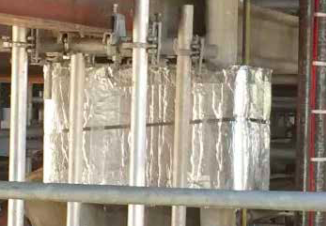
In North America, buildings account for approximately 30 per cent of GHG emissions, despite efforts over the last decade to improve sustainable building with rating systems, environmentally friendly materials, and building techniques and technologies created to lessen buildings’ carbon footprint. Older structures long overdue for environmental retrofit are the primary cause, and a view of GHG emission inventories across Canada illustrates the need – and potential – for mechanical insulation as part of the solution.
According to Environment and Climate Change Canada, Canada’s total GHG emissions for 2014 were 732 megatonnes (Mt) of carbon dioxide equivalent (CO2 eq). While the oil and gas and transportation sectors amounted to the largest contributions in Canada, buildings were right behind with 87.2 Mt / CO2 eq or 12 per cent of the Canadian total—a percentage that has remained steady since 1990.
In the Metro Vancouver region, for instance, commercial, institutional, and residential buildings account for five per cent of smog-forming emissions and 29 per cent of GHG emissions each year. In the Fraser Valley Regional District, buildings are the number two generator of GHG emissions, right behind on-road vehicles. Both regions have undertaken a number of changes to combat emissions, including new tailpipe standards for GHGs that are projected to decrease transportation pollution, leaving buildings in first place.
The City of Calgary has taken a number of measures aimed at reducing GHG emissions, an on-going municipal objective. Its 2011 GHG measurement system update report lists buildings in the top three sources of GHG emissions and recommends a detailed breakdown in how buildings contribute to the issue, by way of fuel consumption, energy use, and other factors. The same year, the City released its Community GHG Reduction Plan, which calls for increased energy efficiency upgrades in buildings and industry, naming electricity use in commercial buildings responsible for 20 per cent of the city’s emissions. Another combined 17 per cent comes from natural gas use in residential and commercial buildings.
The City’s current objective is to reduce GHG emissions by at least 20 per cent by 2020 with a further minimum reduction of 80 per cent by 2050, using 2005 levels as a baseline. In 2015, 21 of Canada’s big city mayors – including Calgary’s – called for binding GHG targets worldwide.
Edmonton tells a similar story, with 15,733,400 tonnes of CO2 eq in 2015, 38 per cent of which came from commercial and residential buildings. It, too, employs a municipal climate action strategy aimed at reducing GHGs to levels consistent with the long-term rise in average global temperature (2 degrees C), increasing energy efficiency in all sectors, and transitioning to cleaner energy.
Saskatchewan received low marks this fall from the Pembina Institute which reported it its Race to the Front publication that the province has Canada’s highest per capita GHG emissions. Major cities, however, have demonstrated early awareness of and commitment to mitigating climate change. Regina was the third city to join the Partners for Climate Protection (PCP) program, established in 1994, at which time a 15 per cent reduction target by 2012 was set. Despite its rapid expansion in oil, potash, and agriculture economies, energy reduction initiatives including a series of retrofits to municipal facilities, have let to an annual 2,500-tonne GHG reduction, though there is still opportunity for improvement.
Saskatoon reported in 2003 that the built environment accounted for 36,270 CO2 eq tonnes. Based on 2001 census, more than half the city’s building stock was constructed after 1970, approximately 11 per cent of commercial buildings were constructed before 1946, and another 15 per cent was constructed between 1946 and 1960. The greatest number of commercial buildings – 25 per cent – was constructed between 1971 and 1980. This is an area of great potential when it comes to retrofit potential.
Although clear data for Winnipeg wasn’t available, in 2014, the Climate Change Connection tallied the Manitoba’s emissions by sector and proportion, with 61 per cent accounting to fossil fuel burning, 29 percent to agriculture, 5 per cent waste disposal, and 4 per cent industrial processes. Of the 61 per cent attributed to fossil fuel burning, 20 per cent is due to “stationary combustion,” which refers to energy used in residential and commercial heating, electricity generation, in the oil and gas industry, and in manufacturing and construction.
Toronto and Ottawa represent Ontario’s major GHG-intensive areas. Thanks to a number of municipal initiatives, Toronto has reduced its city-wide emissions by 18 per cent since 2004 levels, and on a corporate level by 46 per cent since1990 and 25 per cent from 2004. Its residential and commercial buildings currently account for a combined 42 per cent of GHG emissions, which falls just ahead of transportation (excluding rail, plane, and boat) sitting at 41 per cent. In Ottawa, 49 per cent of GHG emissions stem from buildings, and combined with transportation (40 per cent) indicate a strong market for infrastructure and building retrofit.
Data on the east coast indicates buildings are responsible for 59,620 CO2 eq tonnes Halifax alone. The municipality offers a number of incentives to reduce emissions, including boiler retrofits, natural gas conversions, energy efficiency audits, and others. Most buildings in Fredericton were constructed after 1950, and electricity consumption for heat, lights, and hot water in Fredericton homes, businesses, and institutions comprised 65 per cent of its emissions in 2000, and 71 per cent in 2004.
In Canada’s north, GHG emissions are comparatively low, with the majority coming from industrial and natural resource extraction facilities, transportation, and commercial buildings.
Natural Resources Canada (NRCan) points to retrofitting and recommissioning as some of the most cost-effective ways of improving an existing building’s energy performance. Either can yield energy saving of 5 to 20 per cent with a typical three-year or less payback, and annual savings can reach up to 30 per cent in some cases.
According to government reporting in the US, National Insulation Association (NIA) estimates maintenance of insulation at industrial facilities alone could generate more than $3.6 billion in annual energy savings, reduce 83 billion pounds of carbon dioxide and other GHG emissions, and create more than 27,000 jobs every year.
In Canada, mechanical insulation systems are more cost effective than any other energy and operating cost reducing efforts, and can offer a financial payback in as little as six months, depending on the application. The use of mechanical insulation can reduce GHG emissions in buildings by as much as 30 per cent. In fact, according to Mechanical Insulators of Canada, properly installed mechanical insulation across the country would result in projected savings of $480 million in annual energy costs, 4.5 billion kWh in annual electricity, and 4.3 million metric tonnes of GHG emissions.



